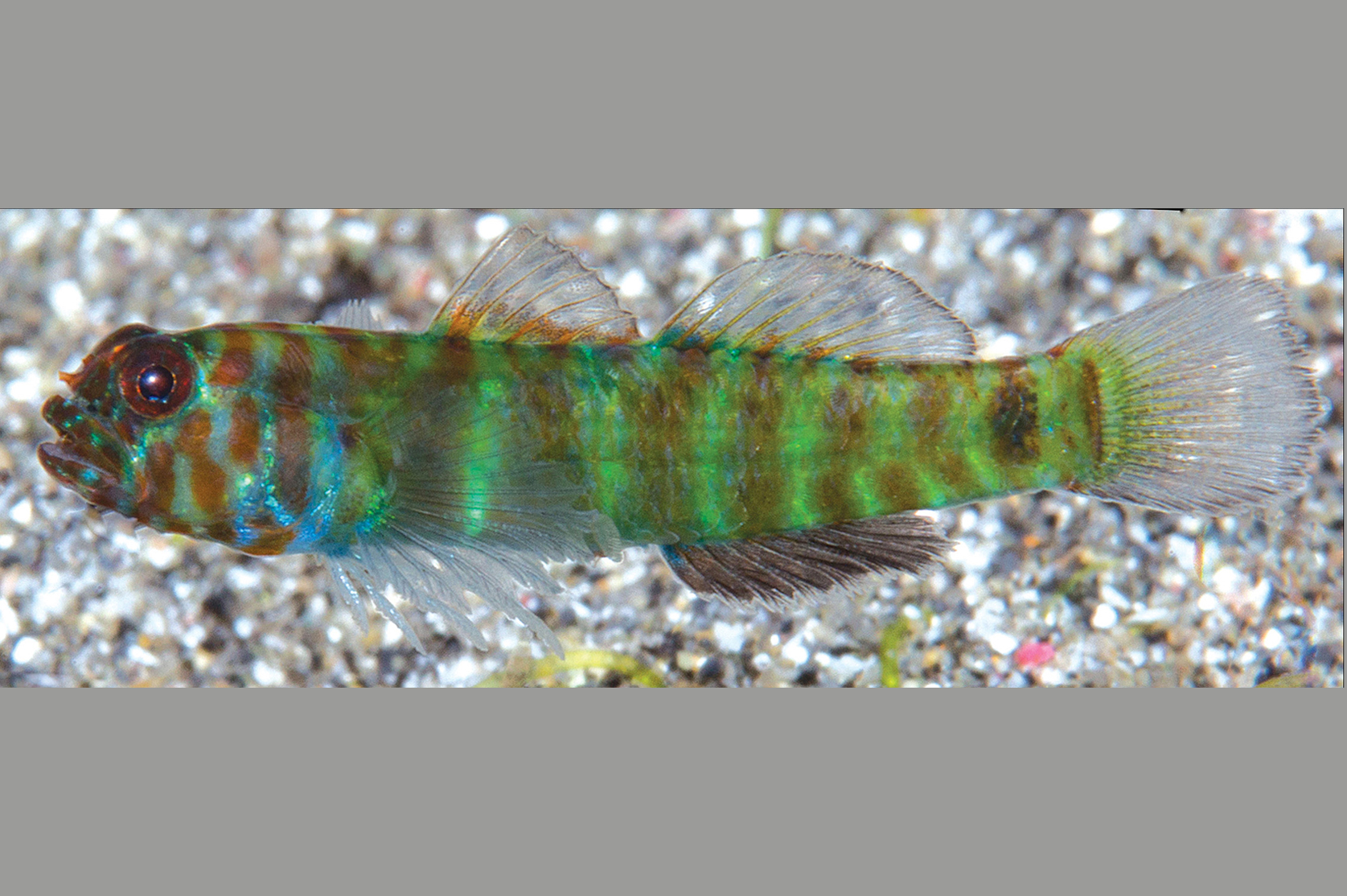- Classification
- ACTINOPTERYGII
- PERCIFORMES
- GOBIIDAE
- Eviota
- bipunctata
Variable Dwarfgoby, Eviota bipunctata Greenfield & Jewett 2016

A Variable Dwarfgoby, Eviota bipunctata, from Timor Leste, CAS 243925. Source: Mark V. Erdmann, Fig. 3, in Greenfield & Randall (2017) Journal of the Ocean Science Foundation 29: 66–71. License: CC BY Attribution
Summary:
A tiny dwarfgoby with a dark bar or one or two distinct dark spots on the pectoral-fin base.
Cite this page as:
Bray, D.J. 2020, Eviota bipunctata in Fishes of Australia, accessed 27 Jun 2025, https://fishesofaustralia.net.au/home/species/5396
Variable Dwarfgoby, Eviota bipunctata Greenfield & Jewett 2016
More Info
|
Distribution |
Off Tantabiddi Creek, North West Cape, Western Australia, depth 0–4 m. Elsewhere the species is widespread in the Indo-west-central Pacific from Aldabra and the Seychelles in the Indian Ocean, east to Ponape, Caroline Islands, north to Taiwan and south to Papua New Guinea and Western Australia. |
|
Features |
Dorsal fin VI + I,7-9; Anal fin I,7-9; Pectoral fin 15-17; Pelvic fin I,4; Caudal fin branched rays 11-13, segmented rays 16-17; Transverse scale rows 6-7; Vertebrae 10+16=26. Cephalic sensory-pore system lacking only the IT pore (pattern 2); only some pectoral-fin rays are branched; pectoral-fin base with 1 or 2 prominent dark spots; dorsal/anal-fin formula usually 8/8; no occipital spots.First dorsal fin rounded in shape, 2nd spine longest, none filamentous |
|
Feeding |
Most males have two intense dark spots on fleshy pectoral-fin. base although some have one large intense dark spot appearing as though two spots merged; large dark spot may consist of densely packed or rather loosely arranged chromatophores or upper portion may be less dense than lower portion of spot.All four conditions may be found in single collections (Fig. 11 ).Females also may have two spots on pectoral-fin base, lower always more intense, or may have spot or only few chromatophores restricted to lower portion of base; also may have single large spot of loosely arranged chromatophores or one with lower portion more intense.Pectoral-fin base spots in females generally less intense than males, with tendency to lose upper spot. Cheek and operculum may have four to five patches of large loosely arranged chromatophores or may be entirely or nearly pale; cheek and operculum markings may continue to underside of head; dorsal portion of head and nape usually unpigmented but some specimens have small chromatophores loosely arranged in irregular transverse markings. Scale pockets heavily pigmented over body, least developed anteriorly, absent on belly region, and most heavily developed on caudal peduncle. Faint brownish Six spots along ventral midline of body posterior to anal-fin origin (postanal spots) and six comparatively wide, subcutaneous bars on lower body associated with midline spots:sixth bar darkest, central portion forming moderately developed subcutaneous caudal peduncle spot; fourth and fifth lower bars merge dorsolaterally forming one bar making five upper and six lower subcutaneous bars.Two broad subcutaneous bars in belly region extending entire depth of body, and inconspicuous subcutaneous bar on upper body above pectoral-fin base.Pigmentation of dorsal fin variable.Spinous dorsal fin of some males with weak dusky horizontal stripe near base, outer portion of fin pale, second dorsal fin of these specimens with weak dusky pigmentation near base and outer two thirds of fin pale; other specimens have eleven to twelve dark spots along dorsal midline of body and these spots extend into basal portion of both dorsal fins, continuing in some to distal portions of second dorsal fin as dusky streaks.Dorsal-fin pigmentation reduced in intensity and development, or sometimes lacking in females. Anal fin blackish with very narrow pale margin, much darker than other fins.Caudal fin lightly dusky basally, most of distal portion pale, posterior margin light dusky.Pectoral and pelvic fins pale or nearly so. |
|
Etymology |
The specific name bipunctata is from the Latin bi- (= two) and punctum (= dot or spot), in reference to the two dark spots on the fleshy pectoral-fin base. |
|
Species Citation |
Eviota bipunctata Greenfield & Jewett 2016, Zootaxa 4121(5): 595, figs 7-11. Type locality: Palawan Province, NW side of Putic Island, Philippine Islands, 10°55'05"N, 121°02'03"E, depth 0-4.6 m. |
|
Author |
Bray, D.J. 2020 |
|
Resources |
Variable Dwarfgoby, Eviota bipunctata Greenfield & Jewett 2016
References
Greenfield, D.W. 2017. An overview of the dwarfgobies, the second most speciose coral-reef fish genus (Teleostei: Gobiidae: Eviota). Journal of the Ocean Science Foundation 29: 32-54. http://dx.doi.org/10.5281/zenodo.1115683
Greenfield, D.W. & Jewett, S.L. 2016. Two new dwarfgobies from the Indian and western Pacific Oceans (Teleostei: Gobiidae: Eviota). Zootaxa 4121 (5): 589-599 http://dx.doi.org/10.11646/zootaxa.4121.5.9
Greenfield, D.W. & Randall , J.E. 2017. Eviota lentiginosa, a new dwarfgoby from Norfolk Island, Australia (Teleostei: Gobiidae). Journal of the Ocean Science Foundation 29: 66-71. http://dx.doi.org/10.5281/zenodo.55695
Greenfield, D.W. & Winterbottom, R. 2016. A key to the dwarfgoby species (Teleostei: Gobiidae: Eviota) described between 1871 and 2016. Journal of the Ocean Science Foundation 24: 53-57 http://dx.doi.org/10.5281/zenodo.21962.
Larson, H. 2019. Eviota bipunctata. The IUCN Red List of Threatened Species 2019: e.T117043966A117044297. https://dx.doi.org/10.2305/IUCN.UK.2019-1.RLTS.T117043966A117044297.en. Downloaded on 07 July 2020.



